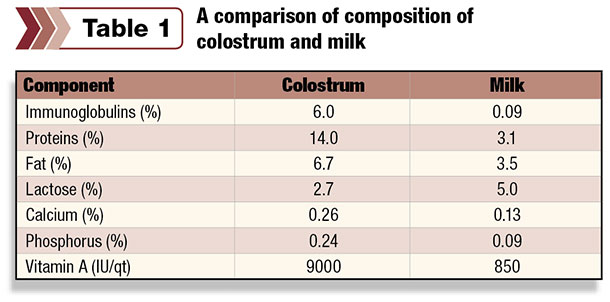Most cattle producers are well aware of the value and importance of assuring that newborn calves receive colostrum soon after they are born. This article will review some information and recommendations about the purpose and value of this practice in helping calves get a good start in life.
Colostrum is a form of milk produced by the mammary glands of mammals in late pregnancy. Most mammal species will generate colostrum just prior to giving birth.
Colostrum contains antibodies to protect the newborn against disease, as well as being higher in fat and protein than ordinary milk.
Colostrum is crucial for newborn farm animals. They receive no passive transfer of immunity via the placenta before birth, so any protection from diseases they need has to be ingested.
This oral transfer of immunity can occur because the newborn’s stomach is more permeable for a relatively short period of time following birth than later in their development.
This means that large proteins (such as antibodies) can pass through the stomach wall. The newborn animal must receive colostrum within six to eight hours of being born for maximum transfer of antibodies to occur.
The stomach wall remains somewhat open up to 24 hours old, but transfer is more limited.
This first milk contains two important components: immunoglobulins and energy sources for the calf.
An immunoglobulin (sometimes called antibodies) refers to proteins that bind to foreign substances like bacteria and viruses (sometimes called antigens) to render these substances ineffective.
The primary immunoglobulins in a cow’s colostrum are IgM and IgG, and each refers to a certain class of immunoglobulin.
IgM antibodies are the largest-sized antibody, while IgG antibodies are the smallest but most common antibody of all the antibodies in the body. IgG antibodies are very important in fighting bacterial and viral infections.

Table 1 shows a comparison of the composition of colostrum and milk from cows. Note the much greater content of immunoglobulins, protein, fat and vitamin A in colostrum compared to milk.
These higher levels provide protection from disease, and greater nutrition for the calf.
Transfer of immunoglobulins from maternal serum to colostrum
During the last four to six weeks prepartum, the cow transfers immunoglobulins from her bloodstream to her udder to start the production of colostrum.
This transfer process is an active, selective transfer process mediated by specific receptors in the udder. During the peak transfer phase, there are approximately 500 grams per week transferred from the cow’s bloodstream to the colostrum in the udder.
The specific immunoglobulins in the cow’s bloodstream are dependent upon her exposure to various diseases and foreign substances.
Mature cows typically have been exposed to more disease agents during their lives than have first-calf heifers and therefore have higher levels of immunoglobulins in their colostrum.
In addition, a primary purpose of vaccinating cows and heifers prior to calving is to stimulate them to produce specific immunoglobulins for transfer to colostrum.
By this process, they provide protection for their calf after the calf consumes colostrum. Since the transfer begins four to six weeks before calving, it is important for vaccinations to the dam to be given prior to this time in order for her to develop the antibodies for transfer to the colostrum.
Failure to ingest colostrum
It is well known that it is important for the calf to ingest adequate quantities of colostrum during the early hours of life.
Most recommendations are that calves consume upwards of 2 quarts within the first 12 hours. Some of the limitations for this level of consumption include:
- Lack of mothering by the dam – If the dam does not mother up well to the calf and encourage nursing, it will be difficult for the calf to obtain this level of colostrum. In cases such as this, the manager may need to restrain the dam and provide colostrum directly to the calf by a tube feeder or bottle and nipple.
- Teat conformation of the dam – Selecting cows for small, normally shaped teats with udders that are suspended at the level of the newborn calf’s head are important considerations to facilitate nursing. Large, balloon-shaped teats or udders that drag the ground are undesirable, and such cows should be culled.
- Weak, cold or stressed calves – These calves are also less likely to have the vigor to stand and nurse following birth. Care should be taken to assure situations where these factors may occur are minimized.
Additional good practices
Livestock breeders commonly bank colostrum from their animals. Colostrum can be stored frozen, but it does lose some of its inherent quality.
Colostrum produced on a breeder’s own premises is considered to be superior to colostrum from other sources because it is produced by animals already exposed to (and thus, making antibodies to) pathogens occurring on the premises.
The priority of colostrum sources should be:
- Colostrum from the calf’s dam
- Colostrum from another cow in the herd
- Colostrum from a dairy cow in the same vicinity as the herd
- Artificial colostral supplements
While supplements are not as good as fresh colostrum from the dam, they have been shown to be effective in supplying nutrition and disease production to newborn calves when other colostrum sources have been exhausted.
If using frozen colostrum, it is best to thaw it in warm water or a warm room rather than using intense heat or boiling water.
This is due to the risk of heat damage to the proteins that comprise the immunoglobulins. Using a microwave should only be considered as a last option, and if used, the microwave should be on a low-energy setting.
Storing and freezing colostrum in a gallon-sized zip-lock bag and pressing the bag flat for freezing enables quick and easy thawing due to the high surface area of the flat bag.
Proper management of cows and calves to assure adequate consumption of high-quality colostrum is important for calves to get off to a good start after birth.
It is hoped that the information provided in this article will help cattle producers successfully meet the needs of their calves. ![]()
 Jack Whittier
Jack Whittier
Beef Management Systems
Colorado State University








